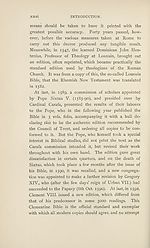Download files
Complete book:
Individual page:
Thumbnail gallery: Grid view | List view

INTRODUCTION.
XXV
in the Vatican Library. But a more famous and more
popular work of this kind was that attributed to the
University of Paris. The Paris Bibles were supposed to
be the result of the careful revision of the best theo¬
logians. Unfortunately this was far from being the
case. As Roger Bacon long ago complained, they were
the work mainly of the stationers—booksellers’ editions
got up for sale, supplying, apparently, the favourite
readings of students from all parts; but they largely
influenced the current text, owing their popularity in
part, perhaps, to the fact that in these Bibles the con¬
venient divisions of our modern chapters were first
adopted.
After the invention of printing, copies of the Vulgate
were multiplied in every quarter at haphazard—the first
manuscript which came to hand being taken as an
exemplar. One hundred and twenty-five editions were
printed before the year 1500. The editions printed at
Basle by Froben in 1491 and 1502 are said to be ex¬
ceptionally good, but the first scholar to produce any¬
thing like a critical edition was Robert Stephens (1st edit.
1538, and 2nd in 1546). The edition of 1546, in which
Stephens made use of several ancient MSS., though he
attached too much value to the ‘ Correctorium Parisiense,’
is practically, says Mr Miller1 in his excellent account
of the Latin version, ‘ the foundation of the modern
Vulgate.’ The Council of Trent, April 1546, while de¬
claring the Vulgate as a version to be authentic and
decreeing its exclusive use, recognised the confusion
which existed in the variety of copies, and directed that
1 In Scrivener’s ‘ Introduction to the Criticism of the New Testament,’ 4th
edit., vol. ii. p. 62.
XXV
in the Vatican Library. But a more famous and more
popular work of this kind was that attributed to the
University of Paris. The Paris Bibles were supposed to
be the result of the careful revision of the best theo¬
logians. Unfortunately this was far from being the
case. As Roger Bacon long ago complained, they were
the work mainly of the stationers—booksellers’ editions
got up for sale, supplying, apparently, the favourite
readings of students from all parts; but they largely
influenced the current text, owing their popularity in
part, perhaps, to the fact that in these Bibles the con¬
venient divisions of our modern chapters were first
adopted.
After the invention of printing, copies of the Vulgate
were multiplied in every quarter at haphazard—the first
manuscript which came to hand being taken as an
exemplar. One hundred and twenty-five editions were
printed before the year 1500. The editions printed at
Basle by Froben in 1491 and 1502 are said to be ex¬
ceptionally good, but the first scholar to produce any¬
thing like a critical edition was Robert Stephens (1st edit.
1538, and 2nd in 1546). The edition of 1546, in which
Stephens made use of several ancient MSS., though he
attached too much value to the ‘ Correctorium Parisiense,’
is practically, says Mr Miller1 in his excellent account
of the Latin version, ‘ the foundation of the modern
Vulgate.’ The Council of Trent, April 1546, while de¬
claring the Vulgate as a version to be authentic and
decreeing its exclusive use, recognised the confusion
which existed in the variety of copies, and directed that
1 In Scrivener’s ‘ Introduction to the Criticism of the New Testament,’ 4th
edit., vol. ii. p. 62.
Set display mode to: Large image | Zoom image | Transcription
Images and transcriptions on this page, including medium image downloads, may be used under the Creative Commons Attribution 4.0 International Licence unless otherwise stated. ![]()
| Publications by Scottish clubs > Scottish Text Society publications > Old series > New Testament in Scots > Volume 1, 1901 > (34) |
|---|
| Permanent URL | https://digital.nls.uk/107720741 |
|---|
| Description | Volume 1. Introduction, Prologe, Matthewe-Luke. |
|---|---|
| Attribution and copyright: |
|
| Description | A collection of over 100 Scottish texts dating from around 1400 to 1700. Most titles are in Scots, and include editions of poetry, drama, and prose by major Scottish writers such as John Barbour, William Dunbar, Gavin Douglas, and George Buchanan. Edited by a key scholarly publisher of Scotland's literary history, and published from the late 19th century onwards by the Scottish Text Society. Available here are STS series 1-3. |
|---|

